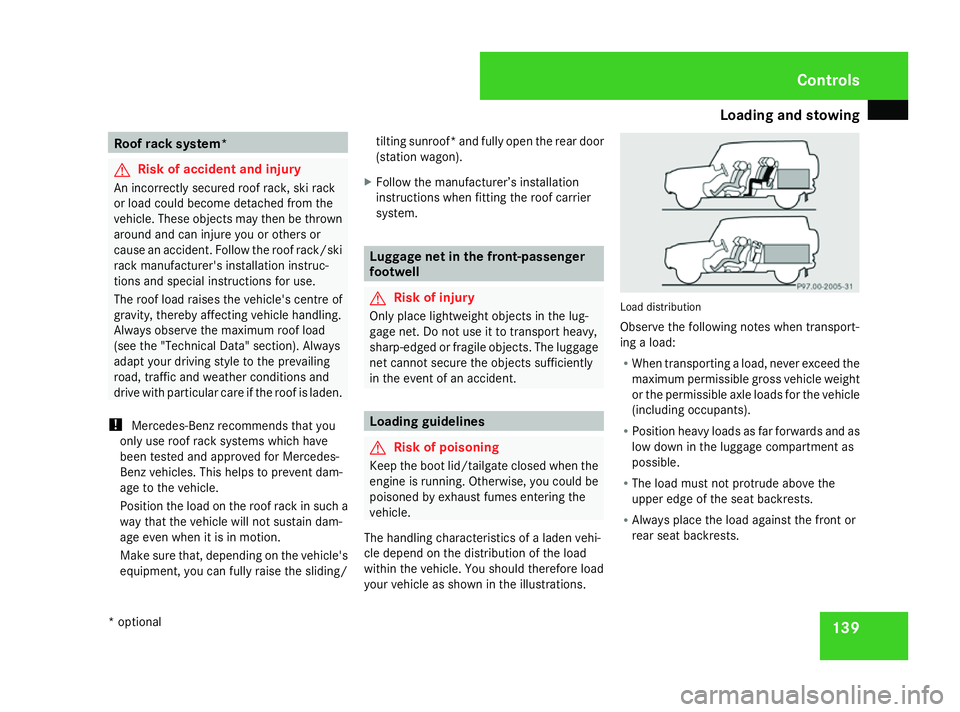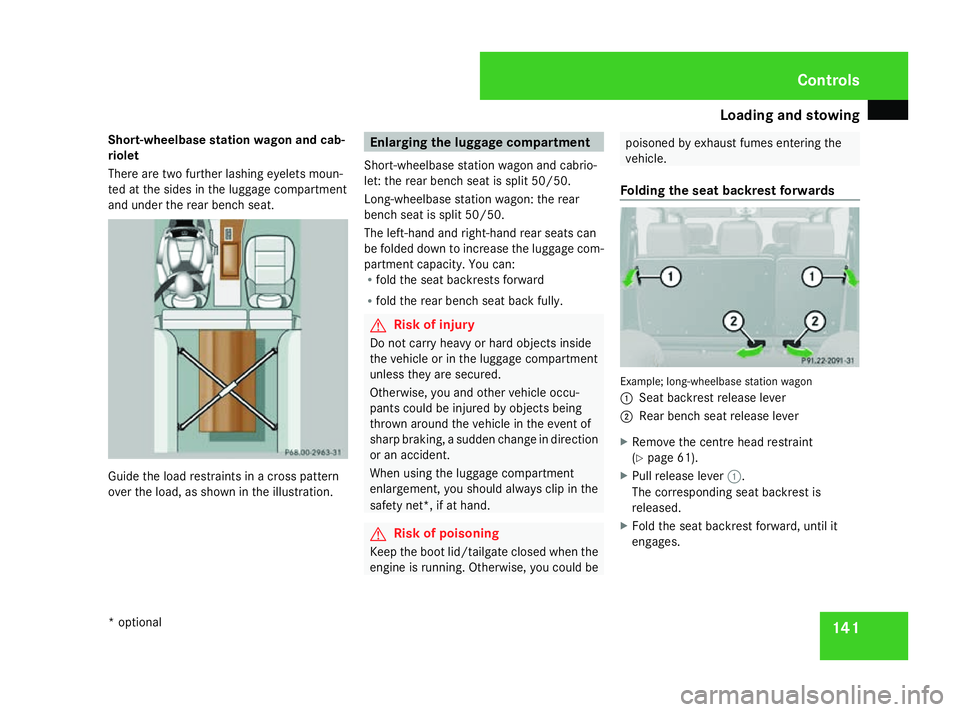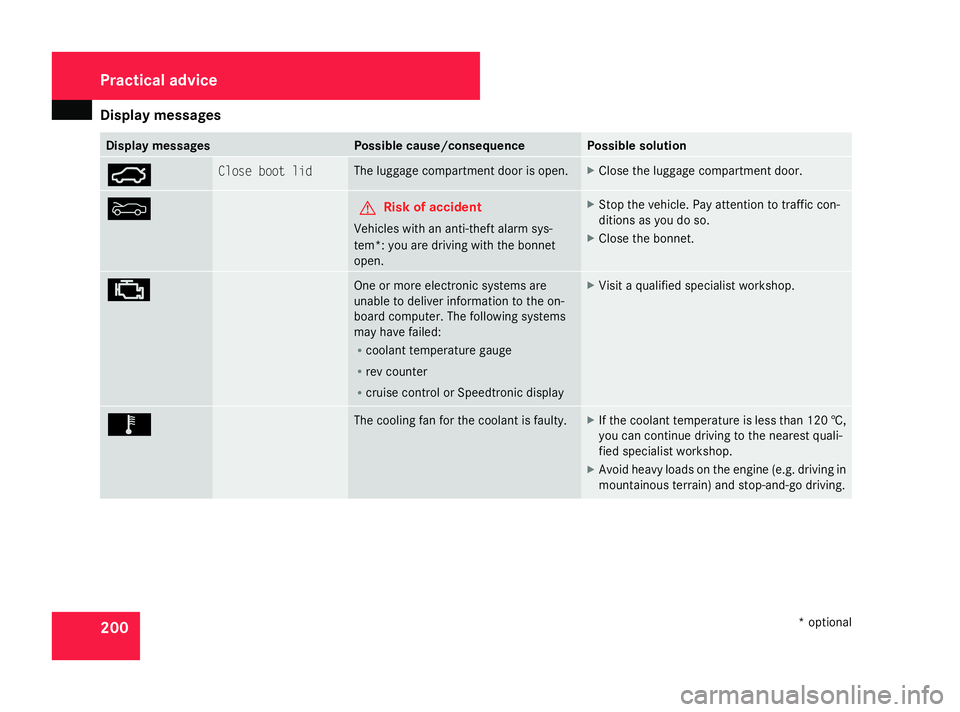boot MERCEDES-BENZ G-CLASS SUV 2008 Owners Manual
[x] Cancel search | Manufacturer: MERCEDES-BENZ, Model Year: 2008, Model line: G-CLASS SUV, Model: MERCEDES-BENZ G-CLASS SUV 2008Pages: 293, PDF Size: 4.49 MB
Page 142 of 293

Loading and stowing
139Roof rack system*
G
Risk of accident and injury
An incorrectly secured roof rack, ski rack
or load could become detached from the
vehicle. These objects may then be thrown
around and can injure you or others or
cause an accident. Follow the roof rack/ski
rack manufacturer's installation instruc-
tions and special instructions for use.
The roof load raises the vehicle's centre of
gravity, thereby affecting vehicle handling.
Always observe the maximum roof load
(see the "Technical Data" section). Always
adapt your driving style to the prevailing
road, traffic and weather conditions and
drive with particular care if the roof is laden.
! Mercedes-Benz recommends that you
only use roof rack systems which have
been tested and approved for Mercedes-
Benz vehicles. This helps to prevent dam-
age to the vehicle.
Position the load on the roof rack in such a
way that the vehicle will not sustain dam-
age even when it is in motion.
Make sure that, depending on the vehicle's
equipment, you can fully raise the sliding/ tilting sunroof* and fully open the rear door
(station wagon).
X Follow the manufacturer’s installation
instructions when fitting the roof carrier
system. Luggage net in the front-passenger
footwell G
Risk of injury
Only place lightweight objects in the lug-
gage net. Do not use it to transport heavy,
sharp-edged or fragile objects. The luggage
net cannot secure the objects sufficiently
in the event of an accident. Loading guidelines
G
Risk of poisoning
Keep the boot lid/tailgate closed when the
engine is running. Otherwise, you could be
poisoned by exhaust fumes entering the
vehicle.
The handling characteristics of a laden vehi-
cle depend on the distribution of the load
within the vehicle. You should therefore load
your vehicle as shown in the illustrations. Load distribution
Observe the following notes when transport-
ing a load:
R When transporting a load, never exceed the
maximum permissible gross vehicle weight
or the permissible axle loads for the vehicle
(including occupants).
R Position heavy loads as far forwards and as
low down in the luggage compartment as
possible.
R The load must not protrude above the
upper edge of the seat backrests.
R Always place the load against the front or
rear seat backrests. Controls
* optional
463_AKB; 1; 8, en-GB
wobuchh,
Version: 2.10.6 2008-07-17T15:19:41+02:00 - Seite 139 ZDateiname: 6515_4091_02_buchblock.pdf; preflight
Page 144 of 293

Loading and stowing
141
Short-wheelbase station wagon and cab-
riolet
There are two further lashing eyelets moun-
ted at the sides in the luggage compartment
and under the rear bench seat. Guide the load restraints in a cross pattern
over the load, as shown in the illustration. Enlarging the luggage compartment
Short-wheelbase station wagon and cabrio-
let: the rear bench seat is split 50/50.
Long-wheelbase station wagon: the rear
bench seat is split 50/50.
The left-hand and right-hand rear seats can
be folded down to increase the luggage com-
partment capacity. You can:
R fold the seat backrests forward
R fold the rear bench seat back fully. G
Risk of injury
Do not carry heavy or hard objects inside
the vehicle or in the luggage compartment
unless they are secured.
Otherwise, you and other vehicle occu-
pants could be injured by objects being
thrown around the vehicle in the event of
sharp braking, a sudden change in direction
or an accident.
When using the luggage compartment
enlargement, you should always clip in the
safety net*, if at hand. G
Risk of poisoning
Keep the boot lid/tailgate closed when the
engine is running. Otherwise, you could be poisoned by exhaust fumes entering the
vehicle.
Folding the seat backrest forwards Example; long-wheelbase station wagon
1
Seat backrest release lever
2 Rear bench seat release lever
X Remove the centre head restraint
(Y page 61).
X Pull release lever 1.
The corresponding seat backrest is
released.
X Fold the seat backrest forward, until it
engages. Controls
* optional
463_AKB; 1; 8, en-GB
wobuchh, Version: 2.10.6 2008-07-17T15:19:41+02:00 - Seite 141 ZDateiname: 6515_4091_02_buchblock.pdf; preflight
Page 203 of 293

Display
messages 200 Display messages Possible cause/consequence Possible solution
Ê Close boot lid The luggage compartment door is open. X
Close the luggage compartment door. Y G
Risk of accident
Vehicles with an anti-theft alarm sys-
tem*: you are driving with the bonnet
open. X
Stop the vehicle. Pay attention to traffic con-
ditions as you do so.
X Close the bonnet. ± One or more electronic systems are
unable to deliver information to the on-
board computer. The following systems
may have failed:
R
coolant temperature gauge
R rev counter
R cruise control or Speedtronic display X
Visit a qualified specialist workshop. Ï The cooling fan for the coolant is faulty. X
If the coolant temperature is less than 120 †,
you can continue driving to the nearest quali-
fied specialist workshop.
X Avoid heavy loads on the engine (e.g. driving in
mountainous terrain) and stop-and-go driving. Practical advice
* optional
463_AKB; 1; 8, en-GB
wobuchh,
Version: 2.10.6 2008-07-17T15:19:41+02:00 - Seite 200Dateiname: 6515_4091_02_buchblock.pdf; preflight